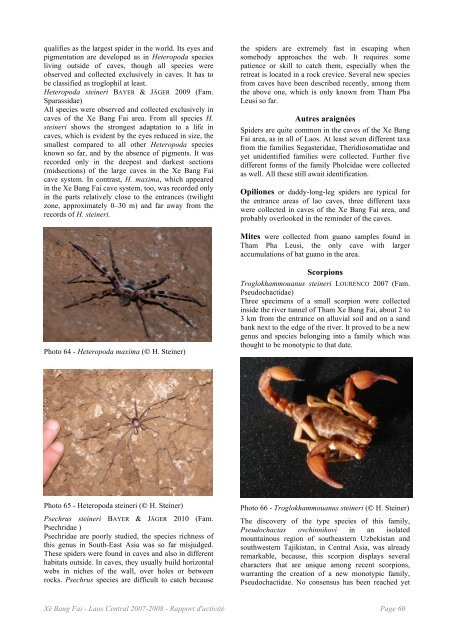EXPLORATIONS SPÉLÉOLOGIQUES EN RÉPUBLIQUE ...
EXPLORATIONS SPÉLÉOLOGIQUES EN RÉPUBLIQUE ...
EXPLORATIONS SPÉLÉOLOGIQUES EN RÉPUBLIQUE ...
Create successful ePaper yourself
Turn your PDF publications into a flip-book with our unique Google optimized e-Paper software.
qualifies as the largest spider in the world. Its eyes and<br />
pigmentation are developed as in Heteropoda species<br />
living outside of caves, though all species were<br />
observed and collected exclusively in caves. It has to<br />
be classified as troglophil at least.<br />
Heteropoda steineri BAYER & JÄGER 2009 (Fam.<br />
Sparassidae)<br />
All species were observed and collected exclusively in<br />
caves of the Xe Bang Fai area. From all species H.<br />
steineri shows the strongest adaptation to a life in<br />
caves, which is evident by the eyes reduced in size, the<br />
smallest compared to all other Heteropoda species<br />
known so far, and by the absence of pigments. It was<br />
recorded only in the deepest and darkest sections<br />
(midsections) of the large caves in the Xe Bang Fai<br />
cave system. In contrast, H. maxima, which appeared<br />
in the Xe Bang Fai cave system, too, was recorded only<br />
in the parts relatively close to the entrances (twilight<br />
zone, approximately 0–30 m) and far away from the<br />
records of H. steineri.<br />
Photo 64 - Heteropoda maxima (© H. Steiner)<br />
Photo 65 - Heteropoda steineri (© H. Steiner)<br />
Psechrus steineri BAYER & JÄGER 2010 (Fam.<br />
Psechridae )<br />
Psechridae are poorly studied, the species richness of<br />
this genus in South-East Asia was so far misjudged.<br />
These spiders were found in caves and also in different<br />
habitats outside. In caves, they usually build horizontal<br />
webs in niches of the wall, over holes or between<br />
rocks. Psechrus species are difficult to catch because<br />
the spiders are extremely fast in escaping when<br />
somebody approaches the web. It requires some<br />
patience or skill to catch them, especially when the<br />
retreat is located in a rock crevice. Several new species<br />
from caves have been described recently, among them<br />
the above one, which is only known from Tham Pha<br />
Leusi so far.<br />
Autres araignées<br />
Spiders are quite common in the caves of the Xe Bang<br />
Fai area, as in all of Laos. At least seven different taxa<br />
from the families Segasteridae, Theridiosomatidae and<br />
yet unidentified families were collected. Further five<br />
different forms of the family Pholcidae were collected<br />
as well. All these still await identification.<br />
Opiliones or daddy-long-leg spiders are typical for<br />
the entrance areas of lao caves, three different taxa<br />
were collected in caves of the Xe Bang Fai area, and<br />
probably overlooked in the reminder of the caves.<br />
Mites were collected from guano samples found in<br />
Tham Pha Leusi, the only cave with larger<br />
accumulations of bat guano in the area.<br />
Scorpions<br />
Troglokhammouanus steineri LOUR<strong>EN</strong>CO 2007 (Fam.<br />
Pseudochactidae)<br />
Three specimens of a small scorpion were collected<br />
inside the river tunnel of Tham Xe Bang Fai, about 2 to<br />
3 km from the entrance on alluvial soil and on a sand<br />
bank next to the edge of the river. It proved to be a new<br />
genus and species belonging into a family which was<br />
thought to be monotypic to that date.<br />
Photo 66 - Troglokhammouanus steineri (© H. Steiner)<br />
The discovery of the type species of this family,<br />
Pseudochactas ovchinnikovi in an isolated<br />
mountainous region of southeastern Uzbekistan and<br />
southwestern Tajikistan, in Central Asia, was already<br />
remarkable, because, this scorpion displays several<br />
characters that are unique among recent scorpions,<br />
warranting the creation of a new monotypic family,<br />
Pseudochactidae. No consensus has been reached yet<br />
Xé Bang Fai - Laos Central 2007-2008 - Rapport d'activité Page 60


